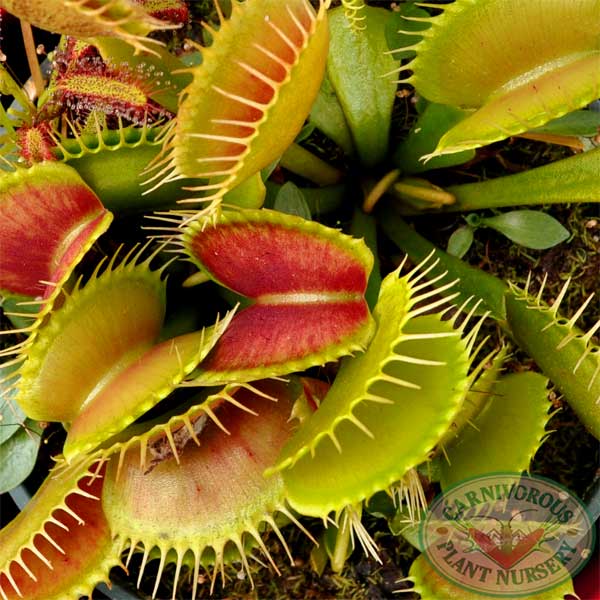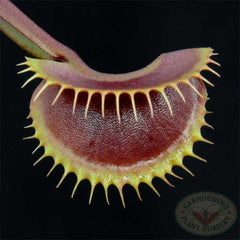
Growing Tips for Venus Flytraps



Venus Flytraps
Soil: 5:3:2, peat:sand:perlite
Container: 4" plastic pot
Watering: moist to wet
Light: full to part sun
Temperature: warm summer, cool winter-tolerates frost
Humidity: medium
Location: outdoors, windowsill, terrarium, greenhouse
Dormancy: yes
Habitat
The Venus Flytrap, Dionaea muscipula, grows naturally in the pocosins of the Cape Fear River basin in the coastal plains between North and South Carolina. It grows among the grasses in the open sun, where the moist soil is typically a sand/peat mix, often sandier than peaty. The climate is warm temperate. The mean summer temperature is 80°F (27°C) and the mean winter temperature is 47°F (8°C) with temperature ranges between 0-104°F (-17-40°C). Rainfall is about 8”/month (20cm) in the Summer and 5”/month (13cm) in the Winter. Companion Carnivorous Plants include Drosera intermedia and Sarracenia flava, among others.
Culture
The Venus Flytrap is fairly tolerant of general Carnivorous Plant growing conditions. A standard Carnivorous Plant soil mix of peat and sand works well. The ratio of peat and sand is not critical. Mature Venus Flytraps prefer a deeper pot of 4-6” (10-15cm) because of their long root(s). It does best when the soil is evenly moist, but not soaking wet. It can tolerate very wet, even submerged conditions, for weeks at a time. Let the soil become drier; yet remain somewhat moist, during winter dormancy. Water from below with mineral-free water. The tray method works very well. Stand the pot in a tray or saucer and keep about 1/2 - 1” (1.25-2.5cm) of water in it at all times during the growing season. Venus Flytraps prefer full sun and develop their best red colors in very bright light. Cultivars grown in lower light may only partially express their distinguishing feature.
Propagation
Flytraps can be propagated from bulb divisions, leaf pulls, and flower spike cuttings. Venus flytrap seeds can be slow and need steady conditions. Stratification (cool, damp winter) is needed for seeds not sown freshly. Note: cultivars can only be propagated asexually from divisions. Seeds by their very nature are a genetic mix and would not grow true to any one of the parents. Tissue culture works well for clones.
Dormancy
A winter rest period is required of mature plants. As day length and temperature diminish the plant will slow its growth and many of the traps will die back. Several traps may remain green during the winter, but they will be slow or ineffective feeders. Cut back on watering and allow the tray to become dry in between waterings, but the soil should stay somewhat moist. Provide cooler temperatures during dormancy. A cold porch or garage may work well. An alternative method is to de-leaf and bare-root the corm (bulb), place it in a vented zip-lock bag with slightly damp peat and a bit of sulfur powder or other fungicide, and keep it in the refrigerator during the winter months (November-March) Shoot for 45 days at 45°F (7°C). Repot in a fresh Carnivorous Plant soil mix in the early spring.
Feeding
Venus Flytraps only need to “feed” about once a month during active growth. Avoid the temptation to feed them. Let the plants catch prey on their own. Even indoors they will attract and capture an occasional fly or other insect. Do not feed them meat or cheese. Complete trap closure to initiate digestion requires a struggling victim. An inanimate piece of hamburger or similar “food” will only sit and rot and possibly kill the trap. If feeding is desired, use tweezers to place a live insect, spider or similar prey that is about 1/3 the size of the trap, directly into the center of the trap. It helps to gently trigger the trigger hairs so that the trap closes around the “meal.” Digestion will take 3-5 days depending upon the temperature, size of the prey, and general health of the plant.
Other Considerations
Avoid closing the traps without a feeding. The plant uses energy to close and reopen. If it does not gain any nutrition, the plant is weakened. Repeated closures without a feeding may kill the plant. One or two closings to show off the plant are okay, just do not over do it.
Traps work for 3-4 feedings and then naturally die and turn black. This is normal and these dead traps may be trimmed away. New traps will emerge.
Dryness, low light, or dramatic changes in temperature can trigger the plant to enter dormancy. The plant may appear to be dying, and lose all of its traps, however, it is likely only beginning to go dormant and dying back to the corm. If this happens, let it rest for a few weeks, and then reintroduce it to healthy Carnivorous Plant conditions. New growth should begin.
It is generally a good idea to remove the flower spike when it forms. If left to grow, it draws energy from the plant and can weaken a potted plant to the point of death.
If the plants are to be grown indoors, consider placing them in a vented terrarium under fluorescent lights with a timer set for 16 hours/day. The lights should be about 6” from the plants.
Repot every few years in a fresh Carnivorous Plant soil mix, since the peat breaks down and can create poor drainage. This is a good time to divide the corm and/or take a few leaf cuttings for propagation. This is best done in the Spring, before active growth begins.
Consider growing Venus Flytraps outdoors. They can tolerate frost or a light freeze. They grow exceeding well in a bog box or bog garden in the yard. They will thrive in full sun and moist Carnivorous Plant soil, naturally catching a variety of insects. In my area, Venus Flytraps flower in June, and go to seed in July, producing many small plantlets by late Summer.
